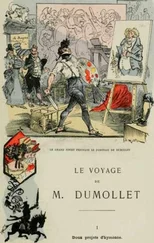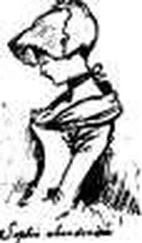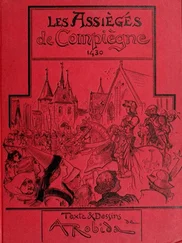Albert Robida - Yester-year; ten centuries of toilette from the French of A. Robida
Здесь есть возможность читать онлайн «Albert Robida - Yester-year; ten centuries of toilette from the French of A. Robida» весь текст электронной книги совершенно бесплатно (целиком полную версию без сокращений). В некоторых случаях можно слушать аудио, скачать через торрент в формате fb2 и присутствует краткое содержание. Жанр: Старинная литература, на английском языке. Описание произведения, (предисловие) а так же отзывы посетителей доступны на портале библиотеки ЛибКат.
- Название:Yester-year; ten centuries of toilette from the French of A. Robida
- Автор:
- Жанр:
- Год:неизвестен
- ISBN:нет данных
- Рейтинг книги:4 / 5. Голосов: 1
-
Избранное:Добавить в избранное
- Отзывы:
-
Ваша оценка:
- 80
- 1
- 2
- 3
- 4
- 5
Yester-year; ten centuries of toilette from the French of A. Robida: краткое содержание, описание и аннотация
Предлагаем к чтению аннотацию, описание, краткое содержание или предисловие (зависит от того, что написал сам автор книги «Yester-year; ten centuries of toilette from the French of A. Robida»). Если вы не нашли необходимую информацию о книге — напишите в комментариях, мы постараемся отыскать её.
Yester-year; ten centuries of toilette from the French of A. Robida — читать онлайн бесплатно полную книгу (весь текст) целиком
Ниже представлен текст книги, разбитый по страницам. Система сохранения места последней прочитанной страницы, позволяет с удобством читать онлайн бесплатно книгу «Yester-year; ten centuries of toilette from the French of A. Robida», без необходимости каждый раз заново искать на чём Вы остановились. Поставьте закладку, и сможете в любой момент перейти на страницу, на которой закончили чтение.
Интервал:
Закладка:
tied in love-knots. The side openings showed rose-coloured stockings, the fashionable colour. Crimson velvet pattens, with very high soles, were worn with these shoes.
Gloves wore equally elegant; they had
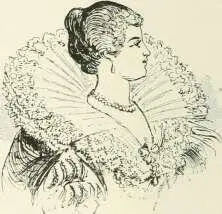
INIédicis ruff.
patterns on the back, and arabesques embroidered on the gauntlet ^ which enclosed the wrist.
The dresses, and indeed all the stuffs of the period, were covered with bunches of 1 Grand Crispin.
HENRY IV. AND LOUIS XIII.
flowers. The present Jardin des Plantes, formerly Jardin du Roi, owes its existence to this fashion ; the primitive nucleus of it, in the time of Henri Quatre, was the garden
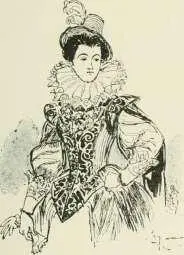
Louis Treize bodice.
of a shrewd horticulturist, who grew all sorts of French and foreign plants, with a view to supplying models to the designers of stuffs or embroideries.
Head-dresses varied. For a long time they remained very high, so as to avoid the ends, or ' horns ' of the ruffs, were waved or curled like an Astrakhan cap, and adorned with jewels only. At a later period ruffs were so altered as to be either bands of cut-lace falling on the square opening of the bodice, or low, if not actually flat, collars.
With these later ruffs it became possible to lower the head-dress ; a small chignon called ' culbute ' was formed behind the head, and the face was framed in pretty falling ringlets or frizzed curls. When this fashion became exaggerated, women's heads looked like round balls, with their frizzy curls and little rings of hair plastered on the forehead.
Now came the stern edicts of Richelieu, who was resolved to prevent French gold from going out of the country to enrich foreign manufacturers by the purchase of Milanese silk braids, and laces or embroideries, to the detriment of French commerce. The edicts afterwards prohibited gold lace and fringe purfling, and lace work enriched with gold
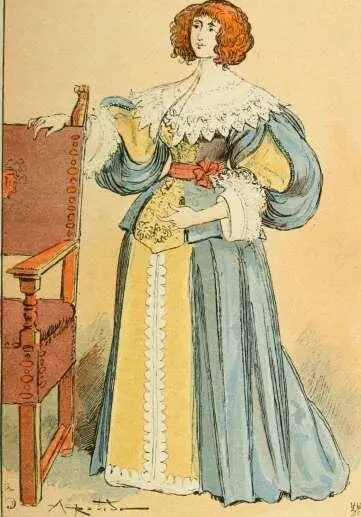
and silv^er stripes, and gold or silver fringes, allowing only narrow stripes of simple stuff. Costume was about to change all of a sudden.
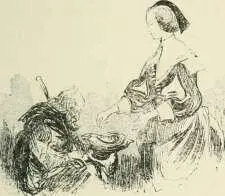
Bourgeoise of the period of Louis XIIL
" II faut serrer ces belles jupes Qui brillent de clinquants divers. On a pris les dames pour dupes, Leurs habits n' en seront point couverts," says a lady, drawn by Abraham Bosse in 1634, after the issuing of the edicts and the reformation of costume.
The change was radical; no more overload-in with ornaments, no more flowered stuffs, no more fine lace from Brussels or Venice. The " lady according to tlie edict," draAvn by Abraham Bosse, wears, over a flat skirt with straiglit-falling folds and not the slightest sign of farthingnle, a bodice with basques, very high at the neck, and fastened by a plain ribbon, the wide sleeves open uj)on an under-sleeve, without either trimming or embroidery. The large ruff, the big frill, either high or flat, is succeeded by a band (' rabat ') of lawn which comes up to the chin. In this costume there remains nothing of the fashion of the sixteenth century ; that mode is dead for good and all, it is of ' yester-year.'
But the new costume, very simple and sober, almost to the point of austerity, is destined to become the fixed costume of women of lesser rank, those bourgeois house-wives, to whom sumptuary edicts cause neither care nor pain ; in fact, in its outlines, it is the costume actually worn by the sisters of Saint Vincent of Paul.
Then did the fair dames take this luudest costume, '-according to the edict," and quickly transform it into one of tiie most eleuant
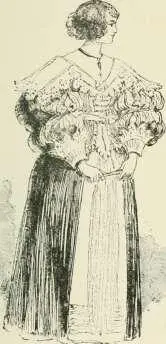
Eiul of tbo reigu of Louis XIII.
and charming ever invented by fashion, a truly remarkable type of high distinction, at the very moment when the masculine costume of the earlier days of Callot, so free, and manly, and kniglitly, was about to change for the worse, to become heavy and constrained, with the jerkin waists up under the arms, and the upper-hose, or breeches, falling over the calf of the leg.
The gown was now worn open from the top to the bottom, showing a bodice-front of light satin, ornamented with tags, and ending in a rounded point on a shirt of silk or reddish-brown satin. The upper dress was widely divided, and rather long, all its folds were on the sides or at the back. The puffed sleeves were cut in narrow bands, fastened on the inner side of the elbow by a ribbon, or opening on a rich under-sleeve of lace, and trimmed at the aperture with tags or bows of ribbon.
No more high frills, only flat ones. The large collars and bands of lawn again displayed some rich embroidery on the points, which fell very low over the shoulders and on the arms, and pointed cuffs of the same embroidery, reacliing from the wrist to the elbow, were adopted.
Bunches and tufts of ribbon everywhere, rosettes on the bodices, garlands of rosettes at the girdles, necklaces of pearls falling on the bosom, strings of jewels fitting to the
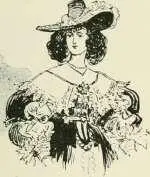
An élégante of the time of Louis XIII.
neck, diamonds and stones on tags and shoulder-knots ; such was the array of the fashionable lady in 16.35, who displayed her rich apparel on the Pkxce Royale to the moustached gallants lounging beneath tlie arcades.
Presently this costume will be worn by the heroines of the Fronde, the duchesses leagued against Mazarin, and afterwards, with certain alterations, it will become full dress costume at the splendid fêtes of the Court of Louis XIV.
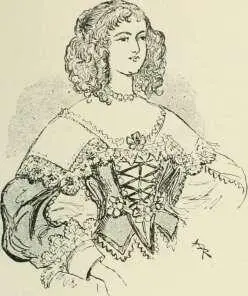
Marion.
VII.
UNDER THE SUN-KING,
Under the Sun-King—From La Valliîre to Maintenon — Gowns called 'transparent' — The triumph of Lace—The Romance of Fashion—Steinkirks—The Fontanges head-dress — The reign of Madame de Maintenon, or thirty-live years of moroseness.
It is the reigu of the Great King ; the sovereignty of sumptuous ornament and majestic solemnity in arclntocture ; it is also the reign of equally solemn and majestic wigs, and of fashions, amazingly luxurious indeed, but more superb than elegant.
" The great century ! " Grandeur is pushed to pomposity, and splendour to ostentation ; the same heavy magnificence prevails in the style of the hotels or palaces wherein dwell bewigged nobles, and in their prim and pompous furniture, as in the dress of men and women, and the refined devices of fashion.
The great reign had a troubled prologue in the Fronde, which enabled the fine ladies to play at flirtatious politics, and to treat themselves to an idea of the emotions of their grandmothers in the days of the League. The strong hand which had held the reins of Government had dropped them, it was cold in death. Richelieu was gone; pranks were possible.
And wliat pranks did not the dukes, and the heroines of the Fronde proceed forthwith to play ? This beginning of things, while as yet
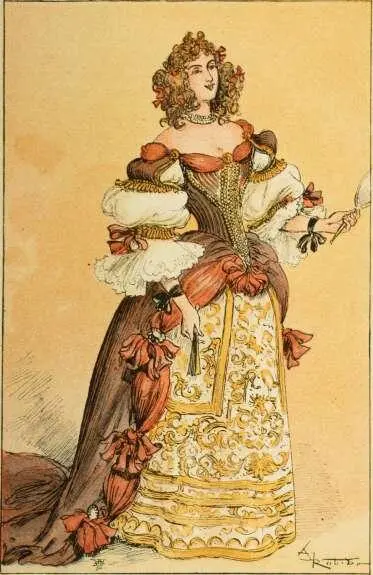
Интервал:
Закладка:
Похожие книги на «Yester-year; ten centuries of toilette from the French of A. Robida»
Представляем Вашему вниманию похожие книги на «Yester-year; ten centuries of toilette from the French of A. Robida» списком для выбора. Мы отобрали схожую по названию и смыслу литературу в надежде предоставить читателям больше вариантов отыскать новые, интересные, ещё непрочитанные произведения.
Обсуждение, отзывы о книге «Yester-year; ten centuries of toilette from the French of A. Robida» и просто собственные мнения читателей. Оставьте ваши комментарии, напишите, что Вы думаете о произведении, его смысле или главных героях. Укажите что конкретно понравилось, а что нет, и почему Вы так считаете.

